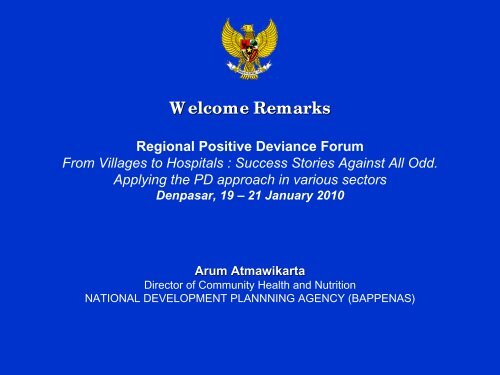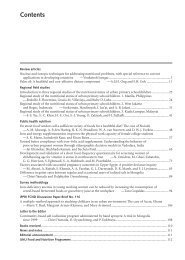Dr. Arum Atmawikarta, Director for Health and Nutrition BAPPENAS ...
Dr. Arum Atmawikarta, Director for Health and Nutrition BAPPENAS ...
Dr. Arum Atmawikarta, Director for Health and Nutrition BAPPENAS ...
Create successful ePaper yourself
Turn your PDF publications into a flip-book with our unique Google optimized e-Paper software.
Welcome Remarks<br />
Regional Positive Deviance Forum<br />
From Villages to Hospitals : Success Stories Against All Odd.<br />
Applying the PD approach in various sectors<br />
Denpasar, 19 – 21 January 2010<br />
<strong>Arum</strong> <strong>Atmawikarta</strong><br />
<strong>Director</strong> of Community <strong>Health</strong> <strong>and</strong> <strong>Nutrition</strong><br />
NATIONAL DEVELOPMENT PLANNNING AGENCY (<strong>BAPPENAS</strong>)
I. Current Situation, Achievement <strong>and</strong> Challenges<br />
of Community <strong>Health</strong> <strong>and</strong> <strong>Nutrition</strong> Problems<br />
in Indonesia
Human Development Index in ASEAN, 2004 ‐ 2007<br />
Tahun<br />
2004 2005 2006 2007<br />
HDI Ranking HDI Ranking HDI Ranking HDI Ranking<br />
Singapore 0,922 25 0,918 28 0,944 23<br />
Brunei<br />
Darussalam<br />
0,894 30 0,919 27 0,92 30<br />
Malaysia 0,805 61 0,811 63 0,823 63 0,829 66<br />
Thail<strong>and</strong> 0,784 74 0,781 78 0,786 81 0,783 87<br />
Philippines 0,763 84 0,771 90 0,745 102 0,751 105<br />
Vietnam 0,709 109 0,733 105 0,718 114 0,725 116<br />
Indonesia 0,711 108 0,728 107 0,726 109 0,734 111<br />
Myanmar 0,583 132 0,585 135 0,568 138<br />
Cambodia 0,583 129 0,598 131 0,575 136 0,593 137<br />
Source : UNDP, Human Development Report 2006‐2009<br />
Note : only Singapore gets the HDI improved
ACHIEVEMENT OF MDGs TARGET<br />
Source : MDG Report, 2009<br />
T.a.d Off track serius Off track On track Tercapai<br />
Indonesia’s Achievement ( )<br />
As of the end of 2008, most of the MDGs has been on track.<br />
Extra ef<strong>for</strong>ts is required to reduce the maternal mortality rate (MMR)
Life Expectancy
Maternal Mortality Ratio (MMR) :<br />
Current Trend <strong>and</strong> Projection
IMR, U5MR, <strong>and</strong> Neonatal Mortality Rate :<br />
TREND & TARGET<br />
.
Prevalence of Underweight among Under5 Children<br />
(1989 – 2007)<br />
Sources : Susenas(1989-2005), Riskesdas 2007
Delivery attendance by skilled health<br />
personnel<br />
Disparity of health<br />
status <strong>and</strong> program<br />
(regional, economic status &<br />
mothers’ education level<br />
Malnutrition <strong>and</strong> Education level<br />
IMR <strong>and</strong> Economic status
<strong>Nutrition</strong> Status in Asian Countries<br />
(periode 2000‐2007)<br />
Country<br />
Low weight<br />
Birth Rate<br />
(%)<br />
Prevalence of<br />
Underweight among U5<br />
Children (%)<br />
Prevalence of Stunting<br />
among U5 Children<br />
Malaysia 9 8 NA<br />
Thail<strong>and</strong> 9 9 12<br />
Philippines 20 28 30<br />
Srilanka 22 29y 14y<br />
Vietnam 7 20 36<br />
Indonesia 9 28 36.8*<br />
Myanmar 15 32 32<br />
Cambodia 14 36 37<br />
Timor Leste 12 49 54<br />
East Asia <strong>and</strong> Pacific 6 14 16<br />
South Asia 27 45 38<br />
Developing Countries 15 26 30<br />
Source: The State of The World’s Children 2009<br />
y : Data refer to years or periods other than those specified in the column heading, differ from the st<strong>and</strong>ard definition or refer to<br />
only part of a country<br />
* Basic <strong>Health</strong> Research Indonesia 2007<br />
(%)
Category A<br />
(Wasted/Stunted)<br />
MALAYSIA<br />
• TIMOR LESTE<br />
LAOS<br />
CAMBODIA<br />
PHILIPPINES<br />
• MYANMAR<br />
• INDONESIA<br />
Category B<br />
Vit.A & Fe Deficiencies<br />
• THAILAND<br />
INDONESIA:<br />
Protein Energy<br />
malnutrition (wasted<br />
<strong>and</strong> stunted)<br />
Vitamin A Deficiency<br />
Iron AnemiaDeficiency<br />
Iodine Deficiency<br />
Overweight<br />
• CHINA<br />
Category C<br />
Overnoursihed<br />
Source : World Bank 2006: Reposition<br />
<strong>Nutrition</strong> as Central to Development
<strong>Nutrition</strong> related problems<br />
• 35 million (15.4%) people live below poverty line (CBS, 2009)<br />
• 32 % of population are at risk of the food scarcity (Susenas,2007)<br />
• More than 7 million children undernourished. (Riskesdas, 2007)<br />
• Only 32.4 % infants of 0‐6 months receives exclusive breast<br />
feeding (DHS, 2007)<br />
• Consumption pattern has not met the requirements according to<br />
the adequacy <strong>and</strong> balanced nutrient intake.<br />
Low consumption of vegetable <strong>and</strong> fruit<br />
excessive fat, salt <strong>and</strong> sugar<br />
• 48.2 % of population ≥ 10 years having less physical excercises<br />
(Riskesdas 2007<br />
• 34% of the ≧ 35 years population, has habit of smoking<br />
(increasing trend)
<strong>Nutrition</strong> related problems….(2)<br />
• Food Products Safety.<br />
– Food products that not meeting the safety requirements in 2002‐2005 is<br />
ranging 40‐60%.<br />
– the use of hazardous materials tend to increase, except <strong>for</strong> <strong>for</strong>malin (2002<br />
– 2005)<br />
– Rejected of exported food products due to the safety aspect, mainly<br />
fishery products<br />
• Disasters have occurred considerably frequent <strong>and</strong> has significant<br />
impact on the food insecurity <strong>and</strong> nutrition status of the people.<br />
• Proportion of urban people has been increasing. <strong>Nutrition</strong><br />
problems in urban even more complex related with its risk factors<br />
i.e. food safety, life style, etc. It includes over nutrition, under<br />
nutrition <strong>and</strong> clinical nutrition.<br />
• Food <strong>and</strong> nutrition problems has not been addressed in<br />
comprehensive <strong>and</strong> holistic manners.
II. Research & Policy Formulation
Role of Research in the Policy making<br />
Quantitative <strong>and</strong><br />
Qualitative research<br />
Research gap :<br />
Many quantitative research<br />
but less qualitative research<br />
Staging<br />
Agenda<br />
Setting<br />
Policy<br />
Formulation<br />
Policy<br />
Implementation<br />
Evaluation<br />
Purpose<br />
Situational<br />
Analysis<br />
Program<br />
Development<br />
Program<br />
impact<br />
Focus<br />
Focus<br />
in the process (activities)<br />
Focus<br />
in the result
PD practices could<br />
help filling the<br />
research gap<br />
Research gap :<br />
Many research<br />
answering<br />
“what”<br />
questions, but…<br />
a few only<br />
answering<br />
“why” .
III. Expectation from PD Forum
EXPECTATION<br />
• PD is becoming recognized globally as an effective approach in<br />
addressing nutrition problem <strong>and</strong> other social problems as well.<br />
• Congratulation <strong>and</strong> appreciation <strong>for</strong> the establishment of Regional PD<br />
Forum in Indonesia<br />
• This 1 st Regional PD <strong>for</strong>um is a good opportunity to share the<br />
experiences of the lessons learnt of PD approach practices from many<br />
countries.<br />
• The <strong>for</strong>um could be able to establish networking among PD experts,<br />
researchers, Lecturers <strong>and</strong> professional practitioners to facilitate the<br />
advanced development of the PD approach.<br />
• Finally, I would like to quote the statement of <strong>Dr</strong>. Jerry Sternin,<br />
father of Positive Deviance, that : “In every community, organization, or<br />
social group, there are individuals whose exceptional behaviors or<br />
practices enable them to get better results than their neighbors with the<br />
exact same resources.”<br />
Meaning that, in any situation, we could mobilize our local wisdom in<br />
addressing the nutrition <strong>and</strong> other social problems in our respective<br />
communities.<br />
• …<strong>and</strong> I assume that many of us in this room are “positive<br />
deviants”.
















